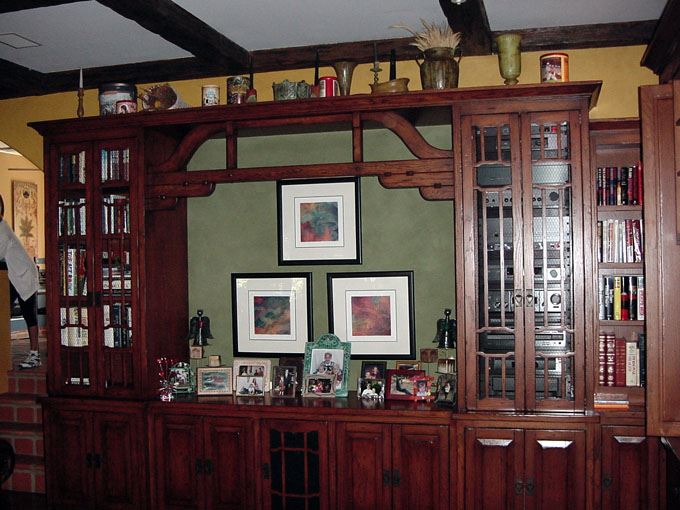
Wood is a beautiful, natural, and historic material to build with, and with a large array of finishing techniques and products available, it can be preserved and displayed in amazing ways. Eventually, a time comes, however, when old or damaged woodwork needs to be refinished. Maybe it’s an antique chair, a well-used table, a wood floor, or a set of cabinets. Refinishing woodwork is a complex endeavor, and each piece is unique, so the exact materials and process can vary greatly. Here are the basic steps, however, that are needed in most wood-refinishing projects.
1. Stripping. The first thing that must be done is to strip off the old finish. This removes the glossy protective coating that would prevent new stain from soaking in, and it removes the previous coloring, to allow for new tinting. There are two basic forms of stripping: mechanical and chemical.
Chemical stripping involves applying a solvent to the surface of the wood, which will break down the protective coating and make it easier to remove. There are dozens of varieties of chemical strippers, some of which will require dry scraping or other wet washing to remove. Consult the expert in your paint or home improvement store to determine the best product for your specific project.
Mechanical stripping is another term for sanding. Some simple restoration jobs can be stripped with an electric sander. Belt sanders are good for tabletops and floors, while orbital sanders are more effective on smaller surfaces. There are also drill and multi-tool attachments available for sanding contours like spindles, legs and chair backs. It is usually going to be unavoidable, however, that you need to do some hand sanding. Use a sanding block to help you with flat surfaces, and a sponge or flexible sanding pad for contoured surfaces.
Important Note: Many wood finishes, especially on older items, contain harmful materials that are released by stripping. Be sure to use adequate breathing and eye protection. Also, stripping chemicals are harsh; protect your skin, and wear old clothing.
2. Preparation: Once the woodwork has been stripped, it will probably need some more attention prior to restaining. Look carefully for flaws in the surface that may need to be sanded out. Begin with courser sandpaper and work towards finer, taking care to work with (in the direction of) the wood grain.
Before applying stain, it is often advisable to use a wood conditioner. This prepares the wood to receive the stain, preventing a splotchy or uneven appearance.
3. Staining: Whatever stain you choose, first apply a small amount to an inconspicuous surface and wait for it to dry. Make sure you are satisfied with the color before proceeding. Use a brush, sponge or cloth to apply the stain liberally to the surface, and let it soak in, but do not apply it so thickly that it runs. The longer you let it soak in, the richer the color will be. Before the stain has dried, use a clean cloth to wipe off the excess, and then allow the wood to dry completely. Repeat if the color is not to the desired depth yet.
4. Finishing: Use a clear coat to cover up the wood, protecting it from moisture, staining, and discoloration. Polyurethane is the most popular choice, though of course there are dozens of lacquers, varnishes, waxes, oils, and chemicals that can provide different kinds of protection and finish. Here it is nearly impossible to give generic advice that will cover every situation, except this: follow the advice on the label!
If you need to use multiple coats (and you probably will), use the finest-grade sandpaper or steel wool to sand in between. Even a sheet of notebook paper has a slight abrasiveness to it that will do the job nicely.
Make sure you wear gloves and work in a well-ventilated area if the product label so directs.
Getting Professional Wood Refinishing Services
If this process sounds complicated or difficult, we must admit that it is. Even for a professional painter or wood restorer, the procedure of refinishing old wooden furniture or cabinets is painstaking.
At ALLBRiGHT 1-800-PAINTING, we take pride in doing high-quality, beautiful work. We pay attention to detail at every stage of wood refinishing, so that the finished products are richly beautiful and long-lasting. Call us for professional wood refinishing services for your:
– Kitchen Cabinets
– Wood Floors
– Custom Millwork or Bookcases
– Exterior Woodwork
– Decks & Porches
– Stair Spindles
– Wood Handrails
– Entertainment Centers
– And more… just ask!
ALLBRiGHT 1-800-PAINTING is Los Angeles’ premier residential and commercial painting contractor. We strive for excellence in every project, from wood refinishing to roller coaster painting! Call us for a free estimate.
